Posted by Anita on 08.10.07 7:08 AM
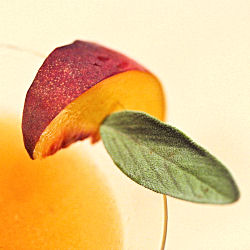 Last year, I put myself on a book diet. Watching my ever-expanding kitchen library take over the countertops, I knew the time had come for serious change. I still allowed myself to purchase cookbooks, but only after thoroughly vetting them first. Usually, this involved borrowing the book from a friend, or from the public library.
Last year, I put myself on a book diet. Watching my ever-expanding kitchen library take over the countertops, I knew the time had come for serious change. I still allowed myself to purchase cookbooks, but only after thoroughly vetting them first. Usually, this involved borrowing the book from a friend, or from the public library.
Even though it’s been difficult to curb the urge to acquire every buzz-worthy title on the market, the system that I fondly call “the new cruelty” has saved me from buying more than a few turkeys. The number of additions to our library has been small, but every one of them gets used regularly.
My real problem, though, was bar books. I’m the abashed owner of what any normal foodie would consider to be an unseemly quantity of cocktailian tomes. Given the vast amounts of spiritous inspiration lurking around every corner of the Internet, my hoard has proven truly unnecessary. In the strictest sense, most mixology manuals aren’t even all that inspirational — they often lack photos, and they’re typically burdened either by purple prose or too-clinical content. Enough, I said, was enough.
So while everyone else swooned over The Art of the Bar during its debut, I smugly folded my arms and turned my head. I have plenty of drinks books, I told myself. Besides, I’m not even that fond of Absinthe (the authors’ place of employment, that is, not the aperitif).
But one afternoon with some time to kill between mid-day appointments, I found myself in front of a local bookstore. I popped inside and headed down to the cookbook department. Grabbing a few titles and heading to the nearest bench, I was sucked into to The Art of the Bar by beautiful full-page photos, artfully styled but still obviously real. The copy was engaging, and the recipes — I grudgingly admitted — were interesting without being too “out there”. In short, it was the cocktail book I could justify buying.
But still I stood my ground for months, even after discovering that the San Francisco Public Library — quite scandalously — does not own a copy of this widely acclaimed title (all the more amusing because you could almost hit Absinthe with a muddler thrown from the roof of the Main Library). After finally scrounging a copy through interlibrary loan, it didn’t take more than a few test drinks to know that my moratorium would crumble.
Living with one of the world’s most unrepentant punsters, it’s not surprising that one of the first recipes I flagged was a little number called Peaches & Herb. Stone fruits had just burst into season as my very own copy arrived on our doorstep, and the new sage plant was thriving — truly, my path was clear.
We’ve been mixing up a batch of these beauties almost every week for the last month, trying little variations here and there. You’ll be pleased to know that orange bitters, or even Angostura, can take the place of the requested peach bitters (although the original is undeniably better).
This month’s edition of Mixology Monday asks us to think orange — and the lovely P&H qualifies twice, both by virtue of its sunny color and one of its key ingredients. Even if you’re colorblind you’ll definitely want yellow peaches here; their white siblings clash with sage’s herbal intensity. And although brandy makes for some mighty smooth sipping, I’d be remiss if I didn’t recommend bourbon as a tremendously interesting variation.


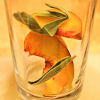


Peaches & Herb
– from The Art of the Bar, by Jeff Hollinger & Rob Schwartz
3 to 4 slices of peach, plus 1 slice for garnish
3 to 4 fresh sage leaves, plus 1 leaf for garnish
splash of simple syrup
1-1/2 oz brandy (or bourbon)
1/2 oz Cointreau orange liqueur
2-3 dashes peach bitters
1/4 oz lemon juice
 In a mixing glass (or cocktail shaker), muddle the peach and the sage with the syrup (if needed, depending on the sweetness of the peach), to make a pulp. Top with ice; add the brandy, Cointreau, bitters, and lemon juice. Shake your groove thing until cold, and strain into a chilled cocktail glass; garnish with remaining peach slice and sage leaf.
In a mixing glass (or cocktail shaker), muddle the peach and the sage with the syrup (if needed, depending on the sweetness of the peach), to make a pulp. Top with ice; add the brandy, Cointreau, bitters, and lemon juice. Shake your groove thing until cold, and strain into a chilled cocktail glass; garnish with remaining peach slice and sage leaf.
cookbooks, Drink of the Week, drinks, Mixology Monday, recipes
10 Comments »




Posted by Anita on 07.30.07 12:48 PM
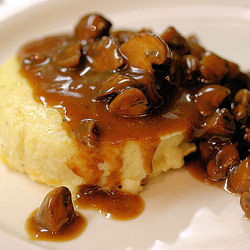 In my new favorite cookbook, Big Small Plates, author Cindy Pawlcyn names her savory corn custard as a brunch favorite. I have no problem believing that this dish flies out of the kitchen, no matter the time of day: We served this recipe a recent dinner party, and our guests all but licked the plates.
In my new favorite cookbook, Big Small Plates, author Cindy Pawlcyn names her savory corn custard as a brunch favorite. I have no problem believing that this dish flies out of the kitchen, no matter the time of day: We served this recipe a recent dinner party, and our guests all but licked the plates.
The first time I made the custard, I used a standard box grater to remove the kernels from their cobs — a messy proposition when dealing with super-fresh farmer’s market corn that spurts milk everywhere. After reading about the Kuhn-Rikon corn zipper in a magazine, I decided to invest in one of these $12 gadgets. Remarkably, it works just like its namesake: Wedge its little crown-shaped tooth at the end of an ear, give a gentle tug, and watch in amazement as two rows of corn unzip right off the cob in perfect alignment.
Does the corn zipper really make this custard better? Given that you end up whizzing the corn to a puree, the answer’s a definite NO. But it certainly makes the prep a lot less messy, and far more amusing. I’d even go so far to say that the corn zipper’s a must-have item if you’re you’re making corn relish or succotash, or any other recipe where whole kernels are a plus, or even if you’re cooking for anyone who loves fresh corn but can’t handle the cob. Yes, Alton acolytes, it’s a unitasker. (But then again, so’s my citrus squeezer, and you’d have to pry it out of my cold, dead hands.) On the plus side: It doesn’t take up much room in the prep drawer, and it’s so freaking cheerful that you just have to smile back — who could resist its happy little face? And as a side benefit, once you own a corn zipper, you’ll have no trouble deciding what to enter into a crazy kitchen gadget event (EDIT: like the one Kathy’s hosting here).
Like other Big Small Plates recipes we’ve tried, this one yields a serious mismatch of sauce and custard quantities. I doubled the sauce on my second attempt, and still ended up with just enough to garnish six servings (albeit rather generously). Either prepare for scantier saucing, or consider doubling the recipe — or at least the stock portion — yet again.




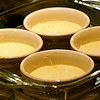
Sweet-Corn Custard with Mushroom Sauce
— adapted from Big Small Plates
Custard
3 ears fresh corn (to yield 2 cups kernels)
2 cups heavy cream
4 large eggs
1 cup (4oz) loosely packed grated Monterey Jack cheese
1 T Dijon mustard
1/2 tsp. salt
1/4 tsp. white pepper
Sauce
4 cups rich stock (beef, chicken, or veal)
2-4 T olive oil
1 pound mushrooms, stemmed and quartered
2 T butter
2 shallots, minced fine
Salt and freshly ground black pepper
Minced fresh chives, for garnish
Using a corn zipper or the coarse side of a box grater, cut the kernels off the cobs. Heat the corn and cream together in a medium saucepan. Bring to a gentle simmer and cook 5 to 10 minutes until the corn is tender. Cool slightly, then puree with a stick blender. (If using a traditional blender, let mixture cool further.) Strain the puree through a fine sieve into a large mixing bowl, pressing well to extract all the liquids. Add the eggs, cheese, mustard, salt, and pepper to the bowl, and stir gently to combine.
Preheat the oven to 325F, and butter eight 6-to-8 oz ramekins. Measure an equal amount of custard into each dish, leaving at least 1/4-inch of headspace. Place the ramekins in a large, shallow pan and carefully fill the pan with enough hot water to reach 2/3 of the way up the side of the ramekins. Cover the pan with aluminum foil, punching a few holes in the top with a skewer, to help prevent condensation drips. Bake the custards in the water bath until just set; start checking at 45 minutes. (The time will depend on the thickness and size of your ramekins, and the size of your water bath.)
To make the sauce, rapidly simmer the stock in a saute pan over high heat until reduced to a sauce-like consistency. Meanwhile, heat the olive oil in another saute pan over medium-high heat. Add the mushrooms and cook, stirring, until they have released their juices and the pan has dried out a bit, 10 to 15 minutes. When the mushrooms are done, salt them to taste and increase the heat to high and pour the stock into the mushroom pan. Bring the stock to a simmer and cook 2 minutes. Just before serving, add the butter and shallots, swirling into the sauce. Season to taste with salt and pepper.
Turn the custards onto individual plates. Pour some sauce over or around each of the warm custards and garnish with the minced chives.
Note: Custards can be kept warm in their water bath for about 20 minutes; if you need to wait longer, refrigerate and gently reheat in a water bath for 10 to 15 minutes before serving. The texture will suffer slightly, but the taste is undiminished.
cookbooks, equipment, other blogs, recipes
12 Comments »




Posted by Anita on 07.25.07 9:21 PM
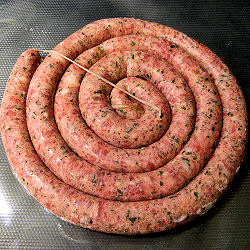 Otto von Bismarck reportedly quipped that “The less the people know about how sausages and laws are made, the better they sleep at night.” Although the ol’ Prussian was undoubtedly right about legislation, when it comes to wurst, I’d beg to differ. Not only is sausage-making entertaining and educational, it’s also much easier than you might think.
Otto von Bismarck reportedly quipped that “The less the people know about how sausages and laws are made, the better they sleep at night.” Although the ol’ Prussian was undoubtedly right about legislation, when it comes to wurst, I’d beg to differ. Not only is sausage-making entertaining and educational, it’s also much easier than you might think.
It can even be fun, especially if you divvy up the work among a crew of like-minded friends. One recent Sunday, we rounded up Sean and DPaul plus our new pals Jon and Karen, classmates from Kasma’s Thai cooking series. Everyone brought a dish to share and a five-pound pork shoulder; Cameron and I provided the recipes, the seasonings, the casings, and other miscellaneous bits. In a matter of hours, the six of us created a spectacular assortment of sausages to stock our freezers.
Between us, we amassed four KitchenAid mixers, three meat grinder attachments, two pairs of sausage-stuffing tubes, and one very porky kitchen. All told, we ended up cranking out more than 25 pounds of sausage. We stuffed a French-style garlic saucisse — courtesy of Michael Ruhlman’s acclaimed Charcuterie — into stout links, curled Kasma’s recipe for spicy sai oa into a hog-casing spiral, squeezed delectable Kentucky-style breakfast sausage into petite sheep casings (plus a few patties), and parceled out our spicy Mexican chorizo in bulk. Even after a hearty sampling, everyone went home with a bit more than a pound of each flavor, with no more effort than making a single batch on their own.
Although we had a blast with the grind-and-stuff method, don’t let a lack of specialized equipment hold you back from making great sausage. Most good butchers will grind any roast to order. Choose a nice, fatty pork shoulder — also known as a Boston butt or simply pork butt, even though it comes from nowhere near the hind end of the pig — and ask for a coarse grind. Mix the ground pork with your seasonings, shape into patties, and voilá: You’ve just made sausage.
Folks were pretty evenly divided about which of our creations they loved best. For me, the winner of the day was the Kentucky breakfast sausage. There’s no stronger compliment that I can pay it than it just tasted right… something like your Southern grandmaw would have made, if you’d been so blessed.
Go on, don’t be shy: Be your own Southern grandmaw. It’s much easier than getting a bill through Congress, I promise.

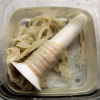

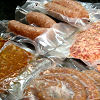

Kentucky Breakfast Sausage
– adapted from Bruce Aidells’ Complete Sausage Book
4 pounds well-marbled pork shoulder, cubed
1-2 pounds pork back fat, cubed
— quantity varies depending on the fattiness of the meat
2 T kosher salt
4 tsp freshly ground black pepper
1/4 cup ground, dry sage
2 tsp ground cayenne pepper
2 tsp ground coriander seeds
1 tsp freshly grated nutmeg
1 cup water
sheep casings (optional)
Cut the pork and fatback into cubes. Place in a metal bowl in the freezer for 30 minutes to chill well, along with the grinder parts. When thoroughly chilled, grind the pork and 1 pound of fatback through the coarse plate of the grinder.
In a large bowl, mix all the ingredients (except casings), kneading and squeezing until well blended. Fry a test patty and taste for seasonings and fat content; adjust as needed.
For links, stuff the sausage into casings and tie or twist at three-finger-width intervals. If making patties, shape the meat into large rolls, 2 inches in diameter. Wrap them in waxed paper, and refrigerate until ready to use; slice into patties as needed.
(Sausage keeps refrigerated for 3 days, or frozen for 2 to 3 months.)
cookbooks, cooking, equipment, meat, recipes
14 Comments »




Posted by Anita on 07.10.07 1:14 PM
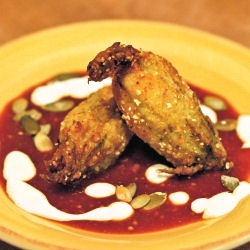 Every summer, I walk by baskets of squash blossoms at the farmers market, longing to find a use for them. Stuffing fragile flowers seemed like a tedious task for a weeknight meal, so I’d always given them a pass. But once I saw Jen’s fritters — which were in turn inspired by a course at Derrick and Melissa’s much-discussed dinner party — I knew I couldn’t put it off any longer.
Every summer, I walk by baskets of squash blossoms at the farmers market, longing to find a use for them. Stuffing fragile flowers seemed like a tedious task for a weeknight meal, so I’d always given them a pass. But once I saw Jen’s fritters — which were in turn inspired by a course at Derrick and Melissa’s much-discussed dinner party — I knew I couldn’t put it off any longer.
The basic idea seemed simple enough: Stuff the blossoms with cheese, dredge them in dairy and starch, and fry until golden. But I wanted to dress them up a bit — make them nice enough to serve as a light supper, alongside a simple salad — so I turned to my new favorite cookbook, Big Small Plates. The text of this popular title is written by Cindy Pawlcyn (of Mustards Grill fame) but the recipes themselves are largely the work of her two partners: Pablo Jacinto, the chef at Cindy’s Backstreet Kitchen, and his brother Erasto, who holds the same title at Mustards.
The book’s tapas-style approach draws inspiration from around the globe. There are plenty of straight-up California-American preparations, and Asia is well represented: A Vietnamese mini-burger salad we tried was especially delicious. But — and here I must admit to being biased — it’s the book’s Latin-influenced dishes that really shine. We’ve tackled a glorious mole casera, two batches of perfectly wonderful empanadas, and a handful of other Mexican-tinged dishes that hit the mark both in taste and in appearance.
The book’s a delight to use, aside from a few scale issues: the empanada recipe yields twice as much filling as wrappers to enclose it, and the original squash-blossom dredge made easily three times as much as I needed (I’ve corrected the proportions below). Most of the recipes serve six as an appetizer course or side dish, but many can serve as two or even four entree-size portions. Some dishes involve prepping multiple sub-recipes, but the auxiliary instructions usually revolve around simple garnishes like the lime-infused crema here. Ingredient lists can seem daunting, but the end results come together with minimal fuss. And they look as good on the plate as they do in the photos — no small compliment in the realm of chef-written cookbooks.
But back to those blossoms. I was worried that I’d waited too long between market day and making the dish: The flowers had started to wilt and the petals were sticking together. But despite their tissue-thinness, and warnings in nearly every recipe I read about the perils of tearing the flowers, the squash blossoms proved surprisingly resilient. Pulling two petals apart at the seam between them, I could split the blossom (much like you would when making a chile relleno) to remove the pollen and stuff the interior. The petal’s own natural moisture combined with the stickiness of the filling meant that I could patch the petals back together after stuffing; the batter held in any remaining leaks during frying.
It was a fiddly process, to be sure, but a highly rewarding one. Once the blossoms are stuffed, you can hold them in the fridge for a few hours. The dredging and frying comes along quite quickly after that, and if your garnishes are prepped and waiting, you’re 90 percent done with a spectacular summer appetizer. (Or one very decadent supper.)

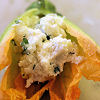
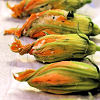
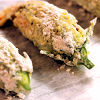
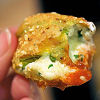
Crisp-Fried Squash Blossoms
adapted from Big Small Plates
2 ears fresh corn
1 tsp olive oil
1/2 cup grated Monterey Jack cheese
1/2 cup fresh ricotta
2 T minced cilantro leaves
—
1/4 cup cornstarch
1/4 cup cornmeal
1/4 cup all-purpose flour
1/2 tsp salt
1/4 tsp freshly ground black pepper
1/4 tsp cayenne pepper
—-
1/2 cup buttermilk
vegetable or canola oil, for frying
—
12 to 18 very fresh squash blossoms
1/4 cup toasted pumpkin seeds
1/4 cup sour cream, mixed with the juice and zest of 1/2 lime
1 cup tomatillo red-chile salsa (homemade or a good store-bought brand), warmed
Cut the kernels off the cobs. Heat the olive oil in a skillet over medium-high heat and saute the corn 2 to 3 minutes. Set aside and allow to cool, then combine with the Jack cheese, ricotta, cilantro.
Open each blossom as gently as possible, and remove the stamen. Stuff each blossom with a spoonful of the cheese-corn mixture; the amount will vary with the size of your blossoms, but don’t be afraid to stuff them well. The flowers seem delicate, but they’re surprisingly resilient. If you need more room to work, peel the flower apart at one of the ‘seams’ between the petals; you’ll be able to pinch everything back together (within reason) using the filling as glue. Leave enough room to twist each blossom shut.
Set the stuffed blossoms on a wax-paper-lined cookie sheet and place in the fridge to set. Meanwhile, combine the cornmeal, cornstarch, flour, and seasonings in a shallow bowl; put the buttermilk in another shallow bowl. Dredge each stuffed blossom, first in the buttermilk, then in the flour mixture, shaking off the excess at each step. Return them to the wax paper, then refrigerate again briefly.
Set up a cooling rack topped with two layers of paper towels next to the frying area. Add oil to a shallow skillet to a depth at least half as high as the average stuffed blossom. (I used 2 cups in a 10-inch pan.) Heat oil to 375 degrees. Slowly lower the blossoms into the pan, four or so at a time to prevent crowding, turning each over as soon as the bottom side is golden brown. It will go rather fast, but if the coating turns dark brown immediately, back off on the heat a bit; you need enough time to melt the cheese. With a spider or slotted spoon, remove the crispy blossoms to the paper towels. Repeat until all blossoms are fried.
Spoon a bit of the warmed salsa on each plate, then top with 2 or 3 blossoms. Drizzle with the lime crema, and scatter toasted pumpkin seeds for garnish.
cookbooks, cooking, farmers markets, Mexican, other blogs, recipes
6 Comments »




Posted by Anita on 07.04.07 7:33 PM
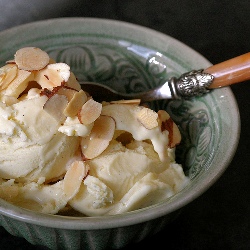 Summertime is finally upon us! Even here in San Francisco — where our summer months are notoriously cold and foggy — the sun is shining high and bright, the skies are a precise shade of coastal blue, and everyone’s outside enjoying the weather. We know it’s merely a respite from the gray gloom that will descend again, without fail; Three days of sun are all San Franciscans ever expect.
Summertime is finally upon us! Even here in San Francisco — where our summer months are notoriously cold and foggy — the sun is shining high and bright, the skies are a precise shade of coastal blue, and everyone’s outside enjoying the weather. We know it’s merely a respite from the gray gloom that will descend again, without fail; Three days of sun are all San Franciscans ever expect.
Another sure sign of the season: Ice cream and sorbet stories are everywhere. Today’s food section turned up as crammed full of ice cream as an apartment freezer: Make it, buy it, stand in line for it… the Chron‘s got us covered in the frozen-confection department.
As if that’s not enough, not one but two blog events this month are dedicated to scoopable sweets: Laura picked sorbet as this month’s “Hay Hay, It’s Donna Day” theme, and Meeta’s Monthly Mingle 12 focuses on ice cream. So I was already flipping through the recipe file when I got an email from the library, telling me that my copy of David Lebovitz‘s new ice-cream book — the darling of the blogosphere — is ready to be picked up, at long last.
OK, wow. Really, I can take a hint: Time to get churning.
I won’t bore you with another gushing post describing what a treat it is to read The Perfect Scoop — I’m too late to the ice-cream social for that, and I couldn’t possibly come up with any more synonyms for “mmmmm!” than you’ve already read elsewhere. Suffice to say that I was bowled over (har har) by all the delectable-sounding options — hello, chartreuse ice cream? — and picking just one recipe proved impossible. I compromised: One ice cream, one sorbet.
Sultry summer weather at the Ferry Plaza Farmers Market seduced us into buying more stone fruit than two people could possibly eat, so we opted to sacrifice a few pounds’ worth for the apricot variation on David’s peach sorbet. Not wanting to overwhelm their perfect ripe essence, we substituted St-Germain liqueur for the recipe’s standard kirsch. The color was vibrant and the flavor sublime, but the texture turned a tad bit grainy for my taste. A beautiful scoop, nonetheless, but nothing to make me abandon my old standby ice-cream book.
Our second trial, though, helped me understand what all the swooning reviews were about. A perfect coconut ice cream doesn’t just toss a cup of shreds into a vanilla custard and freeze them up. Instead, it starts by infusing warm dairy with freshly-roasted coconut, steeping to extract subtle flavors. Then we strain the solids out of the coconut-scented cream, which is used to finish a rich, not-too-sweet custard base (and which I could barely restrain myself from eating with a spoon).
After churning and freezing, the mixture emerged as a beautiful, smooth off-white velvet, redolent with coconut but minus the “pencil shavings” texture that some (including Cameron) find unappealing. We loved it equally on its own and topped with toasted almonds for added crunch. But our favorite treat of all — sure to be the hit of the summer — paired the luscious toasted coconut ice cream with the icy apricot sorbet to make a Creamsicle-style treat to brighten even the cloudiest day.
Bring it on, summer. We’re ready for you.
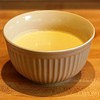
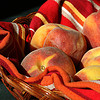
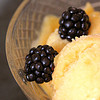
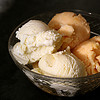
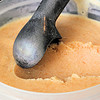
Toasted Coconut Ice Cream
adapted from The Perfect Scoop by David Lebovitz
1 cup unsweetened coconut flakes
1 cup whole milk
2 cups heavy cream (not ultra-pasteurized)
3/4 cup granulated sugar
1 vanilla bean, split and scraped
5 large egg yolks
1 teaspoon dark rum
Toast the coconut on a baking sheet in a moderate (350°) oven for 5 minutes or until golden and fragrant, stirring occasionally to toast evenly.
Warm the milk, half of the cream, and the salt and sugar in a heavy saucepan over medium-low heat. Add the toasted coconut and the vanilla seeds and pod. Cover the pan and remove from the heat to steep.
After an hour, rewarm the infused mixture. Strain through a medium-mesh strainer into another saucepan, pressing down on the solids to extract all the liquid. Discard the solids, reserving the vanilla-bean pieces for another use, if desired.
Combine the remaining cream with the rum in a large bowl. In a separate large bowl, whisk the egg yolks together. While whisking constantly, slowly add the coconut cream to the egg yolks.
Return the custard to the pan and place over medium heat, scraping the mixture to avoid scorching. Cook until the custard coats the back of the spatula. Pour the custard through the strainer into the cream-rum mixture, and cool over an ice bath.
Cover the bowl of cooled custard, and place in the refrigerator until well chilled, preferably overnight. Freeze according to your ice-cream machine’s directions for custard-based recipes.
cookbooks, dessert, other blogs, recipes
11 Comments »




Posted by Anita on 06.15.07 7:02 AM
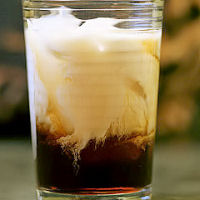 This month’s Mixology Monday, Creme de la Creme, features drinks made with cream-based liqueurs.
This month’s Mixology Monday, Creme de la Creme, features drinks made with cream-based liqueurs.
When our hostess, Anna, allowed that “lazy bums can include cream in their cocktail” in lieu of a cream liqueur, my path became clear.
“Sometimes, there’s a man, well, he’s the man for his time and place. He fits right in there. And that’s The Dude, in Los Anglez. And even if he’s a lazy man — and The Dude was most certainly that. Quite possibly the laziest in all of Los Anglez County, which would place him high in the runnin’ for laziest worldwide.”
A perfect inspiration for lazy, creamy-cocktail drinkers everywhere, wouldn’t you say?
For those of you not acquainted with the Coen Brothers’ 1998 noir parody, The Big Lebowski …well, there’s no way I could possibly convince you of its worth in 20 words or less. Suffice to say that its hysterical, convoluted plot finds room for Jeff Bridges, John Goodman, Steve Buscemi, Julianne Moore, Phillip Seymour Hoffman, John Turturro, Flea, and Tara Reid all on the same screen. It’s a rollicking two hours filled with mistaken identities, bowling tournaments, extortionate Nihilists, and many, many White Russians.
Right there in the opening scene, we find our hero Jeffrey Lebowski — known to all as The Dude, or “His Dudeness, or Duder, or El Duderino if you’re not into the whole brevity thing” — strolling through his local Ralphs. He picks a carton of half-and-half out of the dairy case with a connoisseur’s care, pausing to open the container and sniff the contents.
That particular carton meets a sad fate well before finding its way into The Dude’s signature cocktail, but never fear: Many a vodka-Kahlua-cream concoction appears in The Dude’s mitts as the story unravels. One even serves as the vehicle for a nasty plot twist…
“But… aw, hell. I’ve done introduced it enough.”
Like most cocktails that have been around the block a time or two, the White Russian sports plenty of variations, and a number of competing formulas. The “official” recipe seems a bit out of synch with common usage, proposing a 5:2:3 (vodka, Kahlua, cream) ratio. Most cocktail manuals and drink sites lean more toward a 4:2:1 mix, which I prefer. More vodka seems fine, but an abundance of cream quickly overpowers the Kaluha.
Of course, you could do as many folks — including The Dude, it should be noted — do, and swap the cream for a lighter dairy product. Half-and-half makes a pleasant drink; whole milk will do in a pinch; I can’t recommend low-fat or any of that other what-have-you.





White Russian
2 oz vodka
1 oz Kahlua
1/2 oz cream (or half-and-half, if you’re not into that whole gluttony thing)
Combine the vodka and Kahlua in an ice-filled rocks glass. Float the cream on top.
Drink of the Week, drinks, Mixology Monday, movies & tv, recipes
9 Comments »




Posted by Anita on 06.07.07 11:02 PM
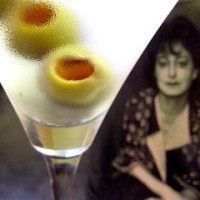 I like to have a martini,
I like to have a martini,
Two at the very most.
After three I’m under the table,
After four I’m under my host.
Michael at A Dash of Bitters reminds us that tonight marks the 40th anniversary of Dorothy Parker‘s demise. She died not, as one would expect (and she might have preferred) from suicide or cirrhosis, but from a heart attack in old age. Her modern notoriety hinges on witty bon mots and wry verse, but in her heyday she was nothing short of a cultural icon, a woman who led trends and set tongues a-wagging.
Mrs. Parker found fame as Vanity Fair‘s drama critic, and later reviewed books for the New Yorker under the sobriquet “Constant Reader”. She penned a pile of short stories, and her semi-autobiographical Big Blonde (although she was a dainty brunette) won the O. Henry prize for short fiction. Later, she and her second husband Alan Campbell became a sought-after Hollywood screenwriting team; the original, Oscar-winning A Star is Born topped their credits.
Although much of the Parker mystique hinges on her wisecracking party-girl persona, in fact she was a near-teetotaler for part of her life. In her twenties, she hardly drank at all. Her biographers tell us that she weathered the ironic excesses Prohibition better than many. One or two drinks a night would be plenty for her, in an era and milieu when an evening on the town typically started at sundown and lasted until breakfast at dawn.
As the years progress, the drinks get stiffer: Dottie’s small beer on the bar beside her pal Robert Benchley‘s large Scotch, an Orange Blossom at the speakeasy, Manhattans at her country house, and, eventually, all-night parties fueled by pitcher after pitcher of Martinis (with no food!). Sweet misery — imagine the mornings after those night-befores:
Drink and dance and laugh and lie,
Love, the reeling midnight through,
For tomorrow we shall die!
(But, alas, we never do.)
In the Algonquin era, the Martini had not yet suffered from modern innovation. None of the Round Table denizens would have recognized the drink as anything other than a well-chilled mixture (always stirred, never shaken) of five or so parts gin to one part dry vermouth, and a dash of orange bitters. No gin, no Martini. If olives weren’t at hand, a simple lemon twist could be substituted, but even this would be noted as a touch unorthodox. One can only imagine what the Vicious Circle would make of so-called Martinis of chocolate, sour apple, or (God forbid) vodka.
Martinis made in the classic style fell out of fashion through the years; some speculate that a lack of proper bitters hastened the drink’s metamorphosis into little more than a bruising-cold glass of gin. Thankfully, renewed interest in classic cocktails means there’s an abundance of delectable orange bitters to choose from today. Our house brand is Regan’s, with a bottle of Hermes on hand as a pleasant alternative. But you’re more likely to find Fee Brothers’ in your local liquor establishment, and that will certainly do just fine. I daresay that once you try your Martini made this way, the modern rendition will seem rather flat and unappealing.
Now, what’s stopping you? As Mr. Benchley would say: Get out of that wet coat and into a dry martini.


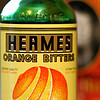
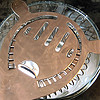

Classic Martini
1-1/2 oz gin
1/2 oz dry vermouth
1 dash orange bitters
Stir with ice, and strain into a chilled cocktail glass. Garnish with olives or a lemon twist.
Drink of the Week, drinks, literary
5 Comments »




Posted by Anita on 06.04.07 12:14 PM
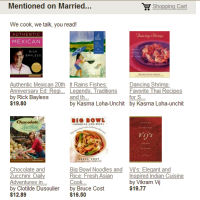 It may have escaped your notice — especially if you’re reading the blog through an RSS reader — that we’ve added a new tab on Married… with Dinner. Ladies and gentlemen, I present you with the Bookshelf.
It may have escaped your notice — especially if you’re reading the blog through an RSS reader — that we’ve added a new tab on Married… with Dinner. Ladies and gentlemen, I present you with the Bookshelf.
Pretty snazzy, eh?
The default page shows all of the books we’ve mentioned on the site, with a link to their Amazon pages for more information. We’ve also built sub-pages that show our favorite books (those that have earned a slot on the bookshelf cubbies in the new kitchen lab-shelves) and for our entire collection.
Our primary motivation in building out the Bookshelf was a desire to have a handy place to link when we mention cookbooks on our site. And, you know, to let you snoop through our bookshelves without having to drop by the house on some pretense or other.
Full disclosure: If you start your Amazon shopping — for these books or any other products — from our site, we earn a small commission. (You don’t pay anything extra, but you get to support us anyway. How cool is that?)
cookbooks, shopping
Comments Off on Bookshelf browsing




Posted by Anita on 05.31.07 2:04 PM
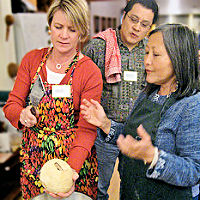 I teased you last week with a glimpse into my Tuesday-night classes with Thai cooking maven Kasma Loha-unchit. This most-recent set of classes was the fourth 4-week series I’ve attended; I started with the beginning series nearly 10 years ago, followed up with the intermediate course a few years later, and then — after travelling with Kasma through central and northern Thailand in January 2006 — picked up again with the advanced series last spring.
I teased you last week with a glimpse into my Tuesday-night classes with Thai cooking maven Kasma Loha-unchit. This most-recent set of classes was the fourth 4-week series I’ve attended; I started with the beginning series nearly 10 years ago, followed up with the intermediate course a few years later, and then — after travelling with Kasma through central and northern Thailand in January 2006 — picked up again with the advanced series last spring.
In the beginning series, you master popular curries, simple stir-fries, spicy soups and salads, and authentic (ketchup-free!) pad thai noodles. Even if you think you know a lot about Thai food, you’re sure to learn a lot: You’ll taste-test multiple brands of coconut milk, learn about the best places to buy ingredients, hear the lowdown on the top brands, and get plenty of practice balancing sweet, salty, sour, and hot flavors under Kasma’s watchful eye.
Intermediate classes move on to more labor-intensive preparations, and a larger assortment of ingredients. By the time you reach this level, you’ll have a thorough understanding of flavors and techniques — pounding curry pastes, balancing flavors, frying ingredients in coconut cream — that will put you in good stead for the advanced courses. A total of six advanced series walk students through regional specialties, intricate preparations, and adventurous foodstuffs. Many students work their way through the entire curriculum and then start again — it’s just that much fun to cook alongside other students who are experienced and passionate about Thai food.
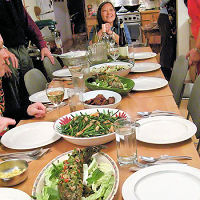 The real joy of learning to cook Thai with Kasma is that she makes Thai cooking accessible without dumbing it down. I hope you won’t think I’m immodest when I say that — even after just the basic courses — I could make Thai food better than what we find at local restaurants. The setup of Kasma’s classes allows for plenty of hands-on work, and lots of time to talk, taste, and learn. Each session starts with a snack while Kasma explains the four to six dishes of the day. Students team up for prep, then gather round as each dish is completed. When the cooking is done, you sit down with Kasma and her charming husband Michael to enjoy the feast you’ve prepared. I promise: You won’t leave hungry.
The real joy of learning to cook Thai with Kasma is that she makes Thai cooking accessible without dumbing it down. I hope you won’t think I’m immodest when I say that — even after just the basic courses — I could make Thai food better than what we find at local restaurants. The setup of Kasma’s classes allows for plenty of hands-on work, and lots of time to talk, taste, and learn. Each session starts with a snack while Kasma explains the four to six dishes of the day. Students team up for prep, then gather round as each dish is completed. When the cooking is done, you sit down with Kasma and her charming husband Michael to enjoy the feast you’ve prepared. I promise: You won’t leave hungry.
Kasma also sells specialized tools and hard-to-find items to her students. Years ago, when I first took the beginning series, her dining-room table was one of the few places to find Thai coffee filters and decent papaya graters. Her offerings have blossomed into a veritable general store of favorite brands and equipment, a useful one-stop-shop when stocking your Asian pantry. Students can also buy from a dwindling stock of Kasma’s award-winning (but out-of-print) cookbooks — Dancing Shrimp and It Rains Fishes — at their original retail price … a big savings over the $40-plus prices you’ll see on Amazon for used copies.
And speaking of bargains: You won’t find a better deal on cooking classes anywhere. Each four-class series costs $160 — just $40 per class, less than you’d probably spend for dinner at your favorite Thai restaurant. Kasma’s house is located close to Oakland’s MacArthur BART station (a quick bus ride or a leisurely half-hour stroll gets you the rest of the way there), making it easy for visitors and bridge-averse City-dwellers to attend. If you live outside the Bay Area, you’re not completely out of luck: Kasma offers week-long intensive sessions each summer for a stunning price: $550. You spend five full days covering territory similar to the beginning and intermediate series, or an assortment of advanced recipes in the later intensives.
Now that I have you salivating, let me disappoint you: You’ll have to be patient. All of Kasma’s classes, especially the beginning series, are perennially booked — and the mention she got in this month’s San Francisco Magazine (alongside Shuna Lydon and June Taylor, among others) will only make matters worse. To finagle a spot, join Kasma’s announcement-only Yahoo group, and be the first to hear about next spring’s offerings.
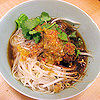
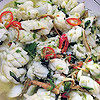
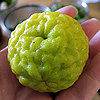
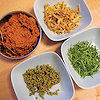
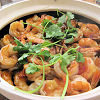
The Art of Thai Cooking
near Piedmont and Grand Avenues
Oakland, CA
510 655-8900
thaifoodandtravel.com
classes, cookbooks, cooking, East Bay, Thai
8 Comments »




Posted by Anita on 05.24.07 10:13 PM
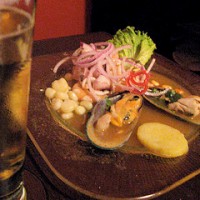 Sometimes, we just don’t post because we’re not eating anything interesting, and there’s just nothing to talk about. But I can assure you, that has NOT been the case these last couple of weeks. We’ve been eating our way around the bay, scheduled to the breaking point: Out of the last 11 evenings, we’ve had nine social engagements. No wonder I’m exhausted!
Sometimes, we just don’t post because we’re not eating anything interesting, and there’s just nothing to talk about. But I can assure you, that has NOT been the case these last couple of weeks. We’ve been eating our way around the bay, scheduled to the breaking point: Out of the last 11 evenings, we’ve had nine social engagements. No wonder I’m exhausted!
Our little foodie death march all started back on Tuesday the 15th, with my second of four sessions in Kasma Loha-unchit’s Thai cooking classes. I’ll post a complete wrap up at the end of the series, but suffice to say that if you’re looking to learn more about Thai cooking, look no further.
Then that Wednesday, we met up with DPaul and Sean to say farewell to our mutual friend Matt (who’s taking a sabbatical from San Francisco for a while) over a sangria-soaked supper at Piqueo’s, Bernal Heights’ new Peruvian cevicheria and small-plates joint. Although the impossibly long menu was nearly entirely different from our first visit a month or so ago, we enjoyed almost everything we’ve tried there so far.
Thursday of the same week found us stuck in traffic on the Bay Bridge approach, on our way to The Blue Door at Berkeley Rep. A car-snarl from hell — more than an hour from SoMa to the Bridge, thanks — meant we missed our Downtown reservations by more than an hour (we called!) and our consolation snack at North Beach Pizza was grim in every way possible. Truly, we were expecting mediocre but fast, and ended up with slow and barely edible.
Saturday we hit the Ferry Building market in the morning, running into Tea at the Rancho Gordo stand. Farmer Steve’s sure the popular boy these days, with dozens of folks stopping by to congratulate him on his much-publicized (and bilingual!) defense against Carlo Petrini’s ill-mannered slagging of the FPFM’s farmers and customers alike. Everyone must’ve bought a bag or three of beans as they stopped by to say “Good on yeh!” to Mr. Sando — many varieties were already sold out by the time we strolled up.
That same afternoon, we hosted two sets of friends and their 2-year-olds for a summer supper of bacon-cheeseburgers, mac salad, and red cabbage slaw, with complete strawberry crisp for dessert. The junior guests had as much fun as their mommies and daddies: Little Toby rocked out on guitar with Cameron, and Miss Martha endeared herself to everyone with sweet hugs and adorable curiosity.
 Monday night, an impromptu get-together chez nous. Tea was in town for the week, so we invited her, plus DPaul and Sean (are they sick of us yet?) — and their sweetie-pie girl Reese — over for dinner. We snacked on pencil-thin asparagus dipped in homemade aioli while we tried out yet another recipe for grilled pizza. I’m still not convinced we’ve found a keeper in the pizza department, but the season’s first peach cobbler proved a hit all around. And when we saw Tea later in the week, she declared that the chopped salad we served with the pizza had earned a slot on the menu of foods she expects to find in heaven. (Flattery like that will get you invited back!)
Monday night, an impromptu get-together chez nous. Tea was in town for the week, so we invited her, plus DPaul and Sean (are they sick of us yet?) — and their sweetie-pie girl Reese — over for dinner. We snacked on pencil-thin asparagus dipped in homemade aioli while we tried out yet another recipe for grilled pizza. I’m still not convinced we’ve found a keeper in the pizza department, but the season’s first peach cobbler proved a hit all around. And when we saw Tea later in the week, she declared that the chopped salad we served with the pizza had earned a slot on the menu of foods she expects to find in heaven. (Flattery like that will get you invited back!)
Tuesday was Thai cooking class again, and Wednesday another dinner to-do: Cameron’s cousins and their 2-year-old (we’re toddler magnets!) were in town from Houston, on their way to Yosemite for the long weekend. Little Camden gobbled a Prather Ranch hot dog while the grownups feasted on tri-tip grilled up Santa Maria style (rubbed with an equal mixture of salt, pepper, and garlic powder moistened with oil), sliced thin and served with guacamole on Rancho Gordo tortillas, with a side of beans a la charra. And yes, another quickie dessert: Pear-rosemary crumble, and vanilla ice cream.
 Tonight we met up with a gaggle of cool food bloggers from SF, the East Bay and beyond for dinner at Berkeley’s stalwart O Chame. We loved every appetizer we shared — especially the seared ahi cubes and their lovely horseradish drizzle, the grilled shiitake mushrooms with fresh asparagus, and the snackalicious green-onion pancake blocks. Our soba and udon bowls were so-so (flavorful broth, but overdone noodles) but scoops of balsamic vinegar caramel ice cream were hauntingly good… and rapidly gone.
Tonight we met up with a gaggle of cool food bloggers from SF, the East Bay and beyond for dinner at Berkeley’s stalwart O Chame. We loved every appetizer we shared — especially the seared ahi cubes and their lovely horseradish drizzle, the grilled shiitake mushrooms with fresh asparagus, and the snackalicious green-onion pancake blocks. Our soba and udon bowls were so-so (flavorful broth, but overdone noodles) but scoops of balsamic vinegar caramel ice cream were hauntingly good… and rapidly gone.
A short stroll down 4th Street led us to Cody’s Books, where we listened to the charming Clotilde speak about her progression from software developer to food blogger to published cookbook author. She gave us all a chuckle when she spoke of the oddness of being a Frenchwoman writing an English-language food blog — to the consternation of some of her compatriots, she confessed — and her passion for ‘dangerous’ recipes like souffles and gougeres, where a cook never knows whether she’s destined for dinner or disaster. (Clotilde’s signing books Saturday afternoon in San Francisco, in case you’d like to meet her and get a copy of her lovely new book.)
Tomorrow? Ugh. I’m more than a little bit sick of cooking, and yet I don’t think I could bear the pressure of going out somewhere new, or even someplace fancy. So… we have reservations at Range, our delightful standby, where they know us just well enough that we can all relax, but not so well that we have to be social. I’m liking that idea a lot. I wouldn’t have missed a single night of the last 2 weeks, but I am sure glad that it’s done.
I’m half hoping that the bounty of the farmers market on Saturday snaps me out of my apathy, but I won’t be surprised (or even too sad) to find that I’ve burned out on planning, prepping, and putting food on the table… at least for a while. We’ve got a freezer full of incredible leftovers from the last six weeks of new-kitchen cooking frenzy, so it’s not like we’ll go hungry.
As we slow down a bit, I’m aiming to do a better job posting here on a more-regular basis. I’ve got a backlog — five posts’ worth and counting — of recipes, photos and stories that should last through a week of diminished cooking capacity. In the meantime, I’ll tide you over with a recipe for an simple (but apparently impressive) salad that’s quick enough for everyday, but with a just enough company-class touches for a weeknight dinner party on the fly. You can vary the vinegar, the cheese, the herbs, and even the olives to complement your main course.
Heavenly Chopped Salad
(adapted from Food & Wine, September 2006)
2 T mild vinegar (such as cider, champagne or sherry)
1 tsp. fresh lemon juice
1 small shallot, chopped fine
1/4 cup extra-virgin olive oil
Salt and freshly ground pepper
—–
2 cups chopped lettuce or baby greens
4-5 small Belgian endive (preferably red) halved, cored and coarsely chopped
1 English or Japanese cucumber, peeled and cut into 1/2-inch dice
1 pint grape tomatoes, halved
2T to 1/4 cup coarsely chopped chives (or other herbs, as you prefer)
3/4 cup pitted kalamata olives, halved (or other olives)
1/2 pound feta (or bleu) cheese, crumbled
Whisk the vinegar, lemon juice, and shallot in a medium bowl. Whisk in the oil until emulsified, and season the dressing with salt and pepper.
Combine the remaining ingredients together in a large bowl. Add half of the dressing, season to taste with salt and pepper, and toss. Add the remaining dressing (or less, to taste) toss again, and serve.
serves 6
Bernal, cookbooks, cooking, East Bay, entertaining, other blogs, restaurants, Thai
3 Comments »




 Last year, I put myself on a book diet. Watching my ever-expanding kitchen library take over the countertops, I knew the time had come for serious change. I still allowed myself to purchase cookbooks, but only after thoroughly vetting them first. Usually, this involved borrowing the book from a friend, or from the public library.
Last year, I put myself on a book diet. Watching my ever-expanding kitchen library take over the countertops, I knew the time had come for serious change. I still allowed myself to purchase cookbooks, but only after thoroughly vetting them first. Usually, this involved borrowing the book from a friend, or from the public library. In a mixing glass (or cocktail shaker), muddle the peach and the sage with the syrup (if needed, depending on the sweetness of the peach), to make a pulp. Top with ice; add the brandy, Cointreau, bitters, and lemon juice. Shake your groove thing until cold, and strain into a chilled cocktail glass; garnish with remaining peach slice and sage leaf.
In a mixing glass (or cocktail shaker), muddle the peach and the sage with the syrup (if needed, depending on the sweetness of the peach), to make a pulp. Top with ice; add the brandy, Cointreau, bitters, and lemon juice. Shake your groove thing until cold, and strain into a chilled cocktail glass; garnish with remaining peach slice and sage leaf.








 In my new favorite cookbook,
In my new favorite cookbook, 




 Otto
Otto 




 Every summer, I walk by baskets of squash blossoms at the farmers market, longing to find a use for them. Stuffing fragile flowers seemed like a tedious task for a weeknight meal, so I’d always given them a pass. But once I saw
Every summer, I walk by baskets of squash blossoms at the farmers market, longing to find a use for them. Stuffing fragile flowers seemed like a tedious task for a weeknight meal, so I’d always given them a pass. But once I saw 




 Summertime is finally upon us! Even here in San Francisco — where our summer months are
Summertime is finally upon us! Even here in San Francisco — where our summer months are 




 This month’s Mixology Monday,
This month’s Mixology Monday, 




 I like to have a martini,
I like to have a martini,





 I
I  The real joy of learning to cook Thai with Kasma is that she makes Thai cooking accessible without dumbing it down. I hope you won’t think I’m immodest when I say that — even after just the basic courses — I could make Thai food better than what we find at
The real joy of learning to cook Thai with Kasma is that she makes Thai cooking accessible without dumbing it down. I hope you won’t think I’m immodest when I say that — even after just the basic courses — I could make Thai food better than what we find at 




 Sometimes, we just don’t post because we’re not eating anything interesting, and there’s just nothing to talk about. But I can assure you, that has NOT been the case these last couple of weeks. We’ve been eating our way around the bay, scheduled to the breaking point: Out of the last 11 evenings, we’ve had nine social engagements. No wonder I’m exhausted!
Sometimes, we just don’t post because we’re not eating anything interesting, and there’s just nothing to talk about. But I can assure you, that has NOT been the case these last couple of weeks. We’ve been eating our way around the bay, scheduled to the breaking point: Out of the last 11 evenings, we’ve had nine social engagements. No wonder I’m exhausted! Monday night, an impromptu get-together chez nous. Tea was in town for the week, so we invited her, plus DPaul and Sean (are they sick of us yet?) — and
Monday night, an impromptu get-together chez nous. Tea was in town for the week, so we invited her, plus DPaul and Sean (are they sick of us yet?) — and  Tonight we met up with a gaggle of
Tonight we met up with a gaggle of